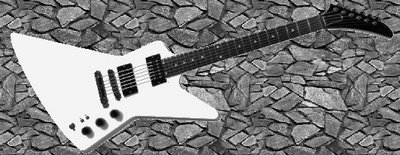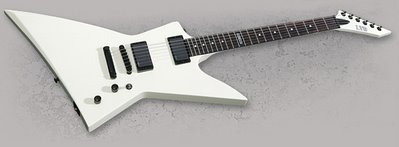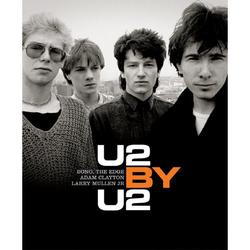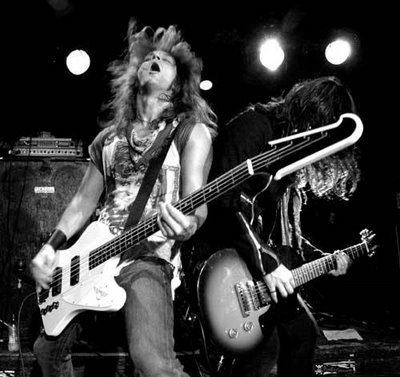- Maple/Ebony compound radius Explorer-style neck with 24-XJ-Stainless Steel frets
- Mahogany Explorer-style body with contoured heel
- JB Humbucker (bridge)
- '59 Humbucker (neck)
- Tune-O-Matic bridge with Stop-bar or string-thru
- Locking Tuners
- Graphite Nut
- Two-vol. One-Tone pot
- 3-way toggle & possibly 2-mini toggles for coil-splitting
 Basically I was looking for an Explorer with a 24-fret neck & no whammy--just a nice, simple bridge. I priced several different builds, compared it to an Epiphone Explorer, a Gibson Explorer, an ESP EX-400, an (on a whim) ESP Viper, and an ESP EC-400. I used Gimp to do mock ups of the 24-fret Explorer with different finishes and hardware. This laborious process continued for too long.
Basically I was looking for an Explorer with a 24-fret neck & no whammy--just a nice, simple bridge. I priced several different builds, compared it to an Epiphone Explorer, a Gibson Explorer, an ESP EX-400, an (on a whim) ESP Viper, and an ESP EC-400. I used Gimp to do mock ups of the 24-fret Explorer with different finishes and hardware. This laborious process continued for too long.Finally I decided I would just settle--I would go with an ESP EX-400 in Olympic White.
 It would be a 22-fret Mahogany/Rosewood neck with it's faux-Explorer-like mahogany body. A big difference would be an EMG active pickup 81 (bridge) / 60 (neck) set instead of the passive Seymour Duncans.
It would be a 22-fret Mahogany/Rosewood neck with it's faux-Explorer-like mahogany body. A big difference would be an EMG active pickup 81 (bridge) / 60 (neck) set instead of the passive Seymour Duncans.Throughout this decision process I have bored my wife with the details of the project. When it came down to the final call I was very surprised at her reaction, but it all worked out very well as you will see...
Here was the kicker, she hated the EX-400--which is what I had settled on! Hated the body style, hated that it would be white, basically told me not to settle for this one. She pushed me to build the one I was after, no settling and absolutely no cheap-o guitars (which I had considered at some point in the process to get some of the features I was after).
Wow. Ok. Hmm.
By chance ,I showed her a guitar that had virtually everything I wanted but a totally different body-style. The EC-400. It comes in three colors: black, white, and see-thru black cherry. White was out (the wife wouldn't have it), black was too "metal" for me, but the black cherry--now there was something. Just the picture on the website was a sight to behold. We both fell in love with that.
It was settled. That would be the guitar. I have always wanted a guitar with EMG pickups anyway so that was a plus too. The only thing missing? Strap-locks (an easy mod) & locking tuners (but it comes with quality Grover tuners so that isn't a real issue anyway).
It was a whirl-wind from there.
I called up our local Sam Ash and asked them if they had any EX-400s or EC-400s in stock. No EXs, but they had two EC-400s in the black cherry--new in the box and, even better, they had just dropped the price to $499! I hadn't seen any for less then $600. That was it. We were on our way.
 So there you have it, two days before Christmas I ended up with a guitar that is not only beautiful to behold but sounds incredible. I knew this was one of the best deals I've ever gotten because it's rich tone comes through unplugged--always a good sign. With the EMG set (which everyone seems to insist is only for metal) it sounds like an acoustic electric on a clean setting.
So there you have it, two days before Christmas I ended up with a guitar that is not only beautiful to behold but sounds incredible. I knew this was one of the best deals I've ever gotten because it's rich tone comes through unplugged--always a good sign. With the EMG set (which everyone seems to insist is only for metal) it sounds like an acoustic electric on a clean setting.For example, I had recorded a bit with it the other day on a little digital recorder. I had forgotten about it amongst so many other recorded snippets, and thought I had done it on our Washburn acoustic/electric. I was blown away when I heard the toggle switch flick and realized that it was the ESP and not the Washburn. It sounds so good.
My take on the EC-400? The finish is flawless. The black hardware looks like it will wear well. The vol & tone pots are smooth. It comes with the Earvana nut, which is a nice plus. The sound is rich & full, coming from the mahogany body & the mahogany/rosewood neck. The action was set to spec from the factory. The pickup heights were also set to spec from the factory. (Impressive, how often do you see that?) The neck is fast, and the XJ frets are just right. The pickups are incredible--they pick up every subtlety in playing and are totally noiseless--clean & dirty they prove why pro players quite often choose them over others. The bottom cutaway on the body allows easy access all the way up to the 24th fret. Only a couple of items need to be taken care of on this guitar. It needs a proper setup by my local luthier (as all new guitars should receive), and there are a couple of frets that need to be dressed because the notes are "dead", otherwise can I just say this guitar rocks? Yeah, I think I can.
My wife (and the salesmen) convinced me that I should get a case for it that day--I thought it would be ok to hold off and just set it on one of my stands. I have to laugh now. How foolish that would have been. The SKB-56 case for about $100 is solidly built, it fits the guitar like a glove and the warranty (the Million Mile Guaranty) for it is out of this world. It has protected my new baby from more then one nearly disastrous occurrences already.
So there it is. I have to give a lot of credit to my wife for this selection.
She's not a player but she knows what she likes, and her wisdom far exceeds mine. When it came down to it, she was pretty insistent and convincing that it either be this guitar or I was going to be building my own.
It may be quite a departure from what I initially intended but it's definitely one of the best early Christmas gifts I can ever remember receiving! This guitar is a solid choice and I recommend it to anyone looking for a nice mid-range priced instrument. I know it's going to serve me well for many years to come.
Tags: Guitar ESP EC-400 Gibson Explorer Epiphone Explorer Warmoth ESP EX-400








